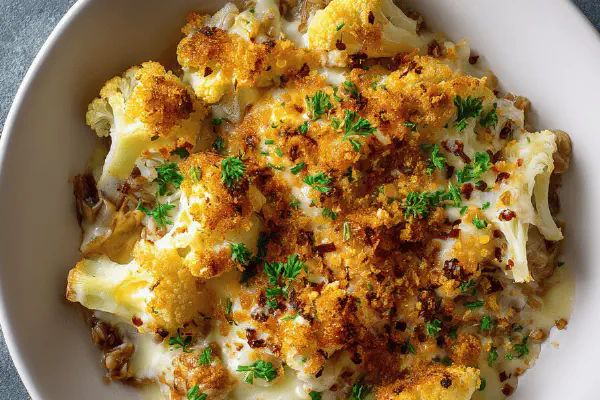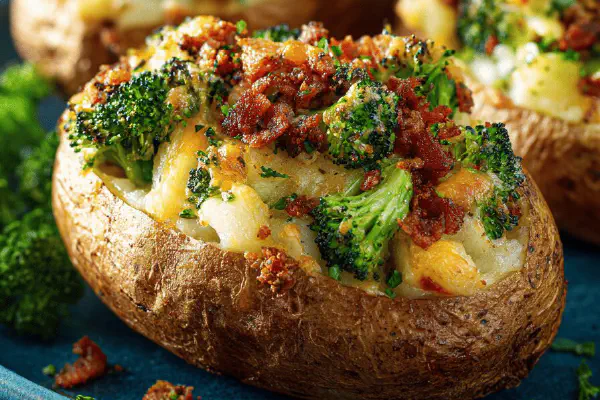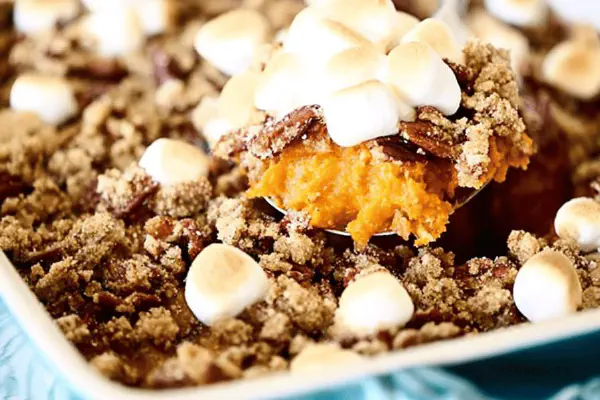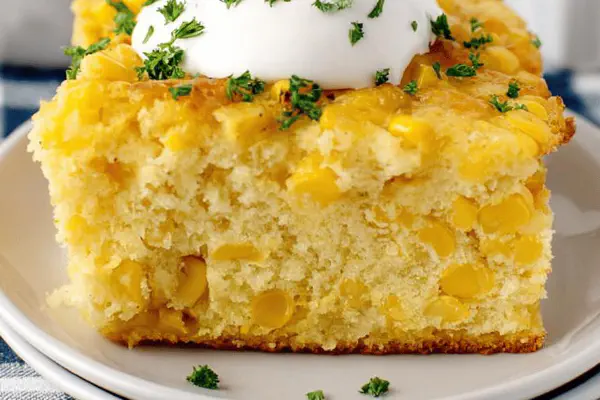Spelt Cauliflower Gratin
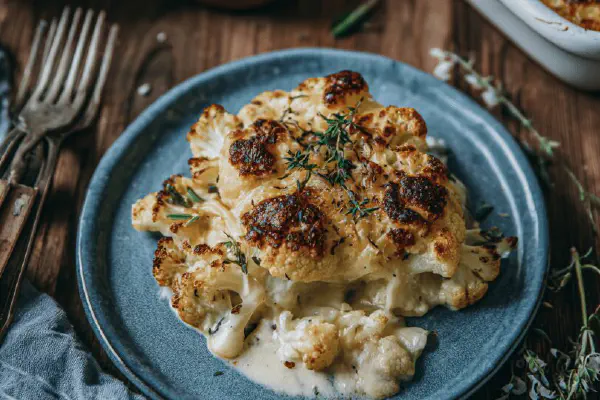
By Emma
Certified Culinary Professional
Ingredients
Spelt mixture
- 220 g (about 1 cup) spelt grains, rinsed
- 2 medium shallots, finely chopped
- 3 cloves garlic, minced
- 50 ml (3 1/2 tbsp) olive oil or clarified butter
- 100 ml (a little less than 1/2 cup) dry vermouth or dry white wine
- 700 ml (about 3 cups) vegetable broth or chicken broth
- 1 bay leaf
- Salt and freshly ground black pepper
Gratin
- 1 medium cauliflower, broken into small florets
- 60 g (1/4 cup) unsalted butter
- 45 g (1/3 cup) unbleached all-purpose flour
- 700 ml (3 cups) whole milk, warmed
- 60 g (3/4 cup) fresh Parmesan cheese, grated
- 1/4 tsp ground nutmeg
- 1/4 tsp smoked paprika instead of cayenne pepper
- 2 tbsp Panko breadcrumbs mixed with remaining Parmesan
- 120 g (1 cup) grated Gruyère or aged cheddar cheese
About the ingredients
Method
Spelt mixture
- In a large heavy skillet (cast iron works), warm oil over medium-high heat. Toss in shallots and garlic. Stir and sauté until translucent and aroma punches—watch closely to avoid browning, about 3 minutes.
- Add the rinsed spelt grains, toss to coat, cook stirring 1 minute. Salt and plenty of black pepper here.
- Splash in the vermouth (or wine). Let it bubble hard, stirring, reduce until almost dry. This deglazes, scrapes flavor bits off pan. If you hear a soft sizzle slowing, ready for next step.
- Pour in broth with bay leaf. Crank heat until broth just boils, then cover, turn to medium-low. Simmer 18-20 minutes. Liquid should mostly absorb, grains plump but still have bite—taste test essentials. Too mushy means overcooked; way too firm, add 1-2 tbsp water and cook few minutes.
- Salt and pepper again if needed. Remove bay leaf. Set aside uncovered to cool slightly.
Gratin
- While spelt cooks, preheat oven to 190°C (375°F). Position rack center.
- Blanch cauliflower florets in salted boiling water 6 minutes or until tender-crisp, not mushy. Tap florets with fork; slight resistance but no crunch. Drain thoroughly—wet florets mean soggy gratin. Toss on kitchen towel if needed.
- In a medium saucepan over medium, melt butter. When foaming stops but not browned, sprinkle in flour. Stir vigorously with whisk for 1 1/2 minutes. This cooks raw flour taste and builds roux — must smell slightly nutty but no color darkening.
- Slowly pour in warmed milk while whisking constantly to avoid lumps. Bring to gentle boil, stir continuously. When thickened to creamy sauce, reduce heat. Let simmer 5-7 minutes stirring often; sauce will coat spoon thickly.
- Off heat, whisk in half Parmesan, nutmeg, smoked paprika. Salt carefully; cheese is salty already. Sauce should be luscious, not gluey. If too thick, splash milk. Too thin? Return to low heat, stir till thickens more.
- Mix Parmesan with breadcrumbs in small bowl for crunchy topping.
- In a large ovenproof dish, spread spelt in an even layer. Scatter cauliflower on top.
- Ladle béchamel evenly over cauliflower. Sprinkle Gruyère generously.
- Top with breadcrumb-Parmesan mix for contrast. Press lightly to stick but don’t compact.
- Cover dish loosely with foil and chill if desired up to 6 hours—makes ahead without sogginess. Bring to room temp before baking.
- Bake uncovered 20-25 minutes or until cheese melts and golden brown, bubbling edges, crust crisp but not burnt. Watch closely last 5 minutes; color changes fast.
- Remove from oven, let rest 15 minutes. Cuts cleaner; flavors settle.
- Serve with kale salad dressed simply with lemon and celery for crisp bite.
Notes and tips
- Spelt sometimes sold as hulled or pearled—pearled cooks faster. Adjust times slightly. Can swap out cauliflower for broccoli or Romanesco—changes texture, flavors but works fine.
- Smoked paprika adds warmth and earthiness—more complex than plain cayenne, less heat. Add cayenne if you crave kick.
- If no fresh Parmesan, use fine aged Pecorino or Grana Padano. For Gruyère replacements, aged Cheddar or Comté work.
- Béchamel can be made dairy-free with oat or almond milk and vegan butter; texture differs but still creamy.
- For quick weeknight, cook spelt in advance, reheat gently with broth before assembling.
- Always drain cauliflower thoroughly, no shortcuts; moisture kills crisp topping.
- Too thick béchamel? A splash of pasta water thins beautifully. Too thin? Flour slurry carefully added while whisking fixes it.
- Cooking times always secondary to visual cues: bubbling sauces, golden crusts, grains tender but chewy, cauliflower yielding when pierced.
- Brown roux too dark burns sauce flavor; pale golden with nutty aroma is sweet spot.
- The layering creates textural adventures — chewy grains, tender veggie, creamy sauce, crispy topping. Trust your nose and eye more than clock.
Cooking tips
Chef's notes
- 💡 Sauté shallots and garlic in oil or clarified butter till aroma wakes nose but avoid browning. Hot skillet, mid-high heat. Quick flick. Onion translucence is your cue. Fat coats spelt. Toast grains first to get nuttier texture; cracked grains turn gummy fast if skipped.
- 💡 Deglaze aggressively with dry vermouth or white wine. Watch liquid bubble hard; color change in pan signals when scraping flavor bits off. If sizzle softens, time to add broth. This is key for depth or spelt dulls. No fancy timings here, smell and color tell all.
- 💡 Simmer spelt covered, low medium heat. Taste test often. Need bite with chew, not mush or stones. Pearled spelt cooks faster, 5 mins less. Add water sparingly if too firm. Salt early plus seasoning at end. Bay leaf pulls aroma without overpowering. Remove leaf before assembling.
- 💡 Blanch cauliflower short time in salted water. 6 mins max. Must be tender-crisp, slight fork resistance but no crunch. Overblanch ruins texture, turns soggy toppings. Drain well and pat dry. Moisture wrecks béchamel crust crispiness. No shortcuts here.
- 💡 Roux needs patience; cook flour in butter just till raw taste leaves but no color darkening. Whisk non-stop. Pour warmed milk slow; lumps kill creamy feel. Sauce thickens steady, coats spoon thick but fluid. Off heat, fold in half of Parmesan, nutmeg, smoked paprika gently. Salt last because cheese salty already.
Common questions
Can I swap cauliflower for something else?
Broccoli works, Romanesco too. Texture shifts but similar method. Watch blanch time; broccoli cooks faster. Flavor changes subtle but bold. Try if craving variety.
What if spelt turns mushy?
Cut cooking early. Quick taste. Overcooked spelt feels gluey. Add splash of water if underdone and stir. Pearled spelt cooks faster, adjust time. Low simmer helps retain chewy bite, no hard cores.
How to keep topping crisp?
Drain cauliflower meticulously. No wet florets. Panko breadcrumbs with Parmesan give crunch. Cover loosely with foil chilling up to 6 hrs okay but bake uncovered for crust browning. Foil traps steam—kills crispness.
What about dairy substitutes?
Use oat or almond milk warmed. Vegan butter ok but sauce thinner, less rich. Nutmeg and paprika help mask changes in flavor profile. Cheese swap aged vegan alternatives but expect less gooey melt.
